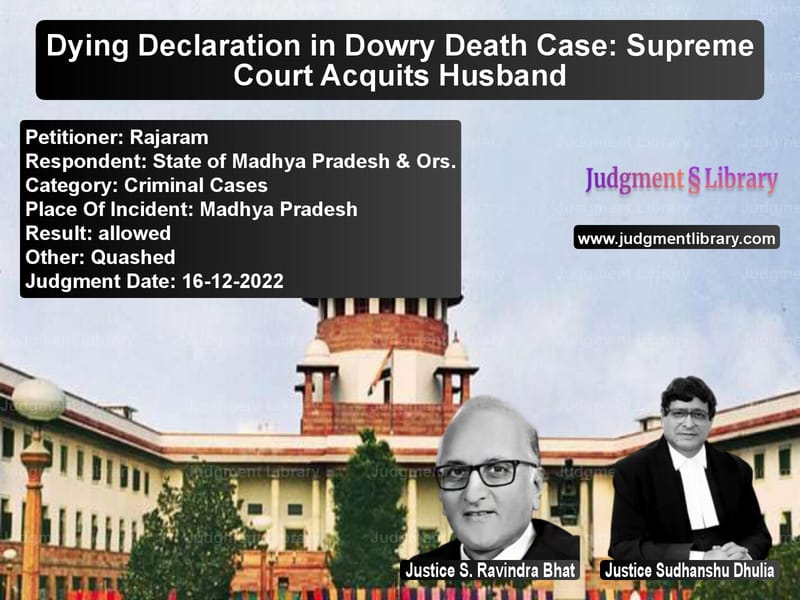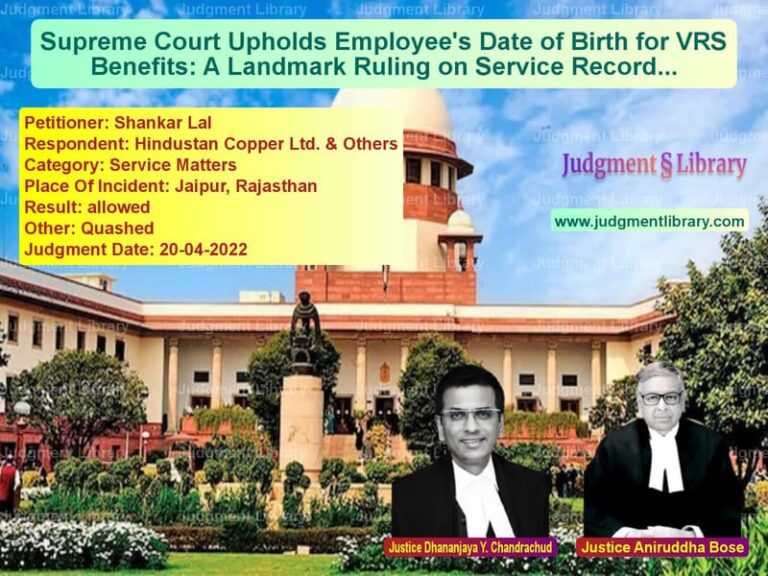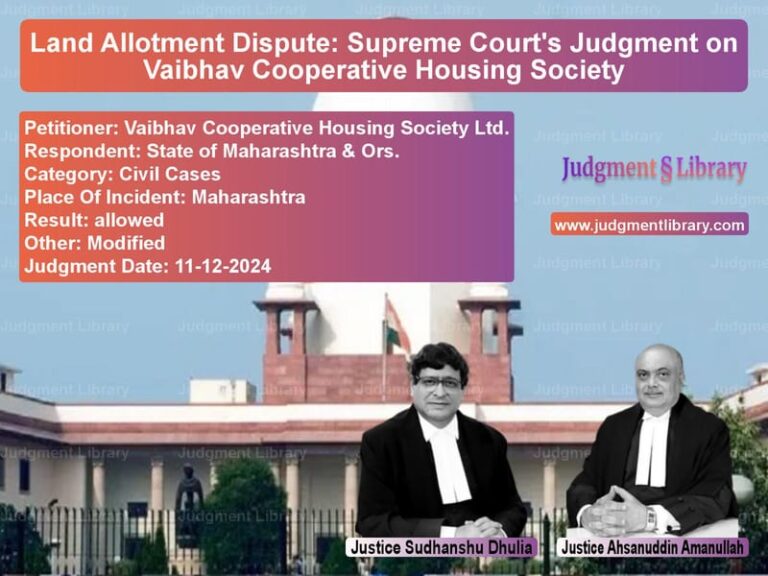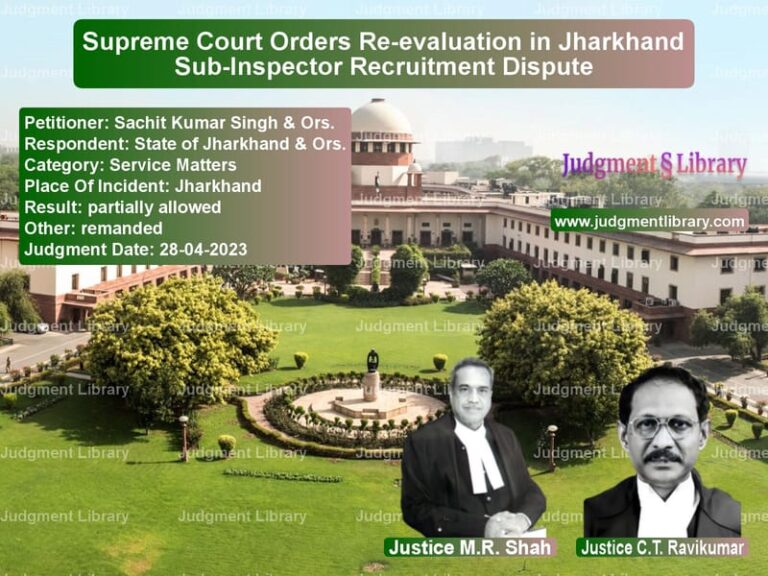Dying Declaration in Dowry Death Case: Supreme Court Acquits Husband
The Supreme Court of India recently ruled in the case of Rajaram vs. State of Madhya Pradesh & Ors., addressing the admissibility of multiple dying declarations in a dowry death case. The appellant, the deceased’s husband, was convicted under Section 498A of the Indian Penal Code (IPC) for cruelty towards his wife, who died due to burn injuries. The Supreme Court overturned his conviction, holding that the prosecution failed to establish guilt beyond a reasonable doubt.
The judgment clarifies the evidentiary value of dying declarations and the importance of consistency in multiple declarations given by the deceased.
Background of the Case
The case involved the death of Pushpa, who was set on fire and succumbed to her injuries. The prosecution alleged that her husband, Rajaram, and his family members were responsible for the crime.
The key events leading to the case were as follows:
- April 23, 2009: Pushpa was admitted to the hospital with severe burn injuries.
- April 23, 2009: Two dying declarations were recorded—one by the Naib Tehsildar and another by the police.
- May 10, 2009: Pushpa succumbed to her injuries.
- 2009: The trial court convicted Rajaram and other accused under Section 498A IPC and sentenced them.
- 2022: The Madhya Pradesh High Court upheld the conviction of Rajaram.
- December 16, 2022: The Supreme Court overturned the conviction and acquitted Rajaram.
Arguments by the Appellant (Rajaram)
The appellant’s counsel presented the following arguments:
- The trial court relied on multiple dying declarations that contained contradictions.
- The first dying declaration (Ex. P-11) recorded by the Naib Tehsildar did not name Rajaram as an accused.
- The second dying declaration (Ex. P-26) recorded by the police named Rajaram, but the High Court itself rejected it.
- The prosecution failed to prove cruelty under Section 498A IPC beyond a reasonable doubt.
- The High Court ignored the fact that no medical certification was obtained before recording the dying declaration.
Arguments by the Respondents (State of Madhya Pradesh)
The prosecution countered:
- The deceased gave two dying declarations, which corroborated the cruelty allegations.
- The first dying declaration (Ex. P-11) described burn injuries but did not name Rajaram.
- The second dying declaration (Ex. P-26) mentioned dowry harassment and named Rajaram.
- The trial court properly considered the overall evidence and convicted Rajaram under Section 498A IPC.
Supreme Court’s Judgment
The Supreme Court ruled in favor of the appellant and acquitted him, holding:
- The High Court rejected the second dying declaration (Ex. P-26), which was the only evidence against Rajaram.
- The first dying declaration (Ex. P-11) did not implicate Rajaram in any wrongdoing.
- “Having regard to the above circumstances, especially the fact that the only evidence against the appellant, i.e., Ex. P-26 was discredited by the High Court, there is no other material to sustain his conviction.”
- The absence of medical certification before recording the dying declaration further weakened the prosecution’s case.
Key Precedents Cited
The Supreme Court relied on multiple landmark cases, including:
- Laxman vs. State of Maharashtra (2002): Clarified that dying declarations must be recorded in a fit mental state.
- Jagbir Singh vs. State of NCT Delhi (2019): Stressed the need to scrutinize inconsistencies in multiple dying declarations.
- State of Haryana vs. Bhajan Lal (1992): Established guidelines for quashing criminal cases based on unreliable evidence.
Impact of the Judgment
This Supreme Court ruling has several major implications:
- Ensures fair trials: Convictions cannot be based on inconsistent dying declarations.
- Protects against wrongful conviction: Mere allegations of cruelty must be supported by strong evidence.
- Clarifies evidentiary standards: Courts must ensure dying declarations meet legal criteria before relying on them.
Conclusion
The Supreme Court’s ruling in Rajaram vs. State of Madhya Pradesh & Ors. reinforces the importance of consistency in dying declarations. The judgment ensures that criminal convictions are based on reliable evidence and protects individuals from wrongful prosecution based on weak or contradictory testimony.
The verdict sets an important precedent for future dowry death cases, ensuring that only credible evidence leads to convictions under Section 498A IPC.
Petitioner Name: Rajaram.Respondent Name: State of Madhya Pradesh & Ors..Judgment By: Justice S. Ravindra Bhat, Justice Sudhanshu Dhulia.Place Of Incident: Madhya Pradesh.Judgment Date: 16-12-2022.
Don’t miss out on the full details! Download the complete judgment in PDF format below and gain valuable insights instantly!
Download Judgment: rajaram-vs-state-of-madhya-prad-supreme-court-of-india-judgment-dated-16-12-2022.pdf
Directly Download Judgment: Directly download this Judgment
See all petitions in Fraud and Forgery
See all petitions in SC/ST Act Case
See all petitions in Judgment by S Ravindra Bhat
See all petitions in Judgment by Sudhanshu Dhulia
See all petitions in allowed
See all petitions in Quashed
See all petitions in supreme court of India judgments December 2022
See all petitions in 2022 judgments
See all posts in Criminal Cases Category
See all allowed petitions in Criminal Cases Category
See all Dismissed petitions in Criminal Cases Category
See all partially allowed petitions in Criminal Cases Category







